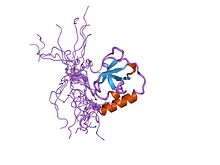Tudor domain
| TUDOR domain | |||||||||
|---|---|---|---|---|---|---|---|---|---|

Structure of a TUDOR domain.
|
|||||||||
| Identifiers | |||||||||
| Symbol | TUDOR | ||||||||
| Pfam | PF00567 | ||||||||
| Pfam clan | CL0049 | ||||||||
| InterPro | IPR008191 | ||||||||
| SMART | TUDOR | ||||||||
| PROSITE | PDOC50304 | ||||||||
| SCOP | 3fdr | ||||||||
| SUPERFAMILY | 3fdr | ||||||||
| CDD | cd04508 | ||||||||
|
|||||||||
| Available protein structures: | |
|---|---|
| Pfam | structures |
| PDB | RCSB PDB; PDBe; PDBj |
| PDBsum | structure summary |
In molecular biology a tudor domain is a conserved protein structural domain originally identified as a region of 50 amino acids found in the Tudor protein encoded in Drosophila. The structurally characterized Tudor domain in human SMN (survival of motor neuron) is a strongly bent anti-parallel β-sheet consisting of five β-strands with a barrel-like fold and recognizes symmetrically dimethylated arginine.
The proteins TP53BP1 (Tumor suppressor p53-binding protein 1) and its fission yeast homolog Crb2 and JMJD2A (Jumonji domain containing 2A) contain either tandem or double Tudor domains and recognize methylated histones.
Other tudor domain containing proteins include AKAP1 (A-kinase anchor protein 1) and ARID4A (AT rich interactive domain 4A) among others. A well known Tudor domain containing protein is Staphylococcal Nuclease Domain Containing 1 (SND1)/Tudor-SN/p100 co activator. SND1 is involved in RISC complex and interacts with AEG-1 oncogene. SND1 is also acts as an oncogene and plays a very important role in HCC and colon cancer. The SND1 tudor domain binds to methylated arginine in the PIWIL1 protein. Tudor containing SND1 promotes tumor angiogenesis in human hepatocellular carcinoma through a novel pathway which involves NF-kappaB and miR-221. Tudor SND1 is also present in the Drosophila melanogaster.
...
Wikipedia
